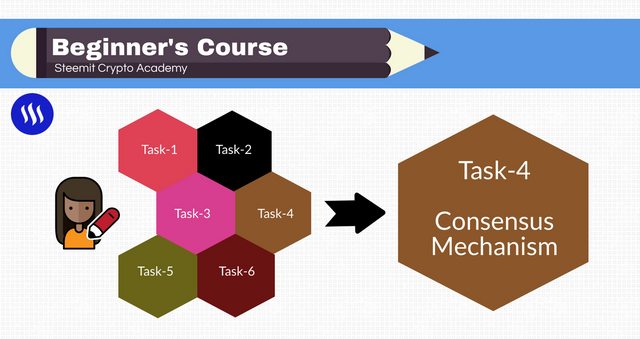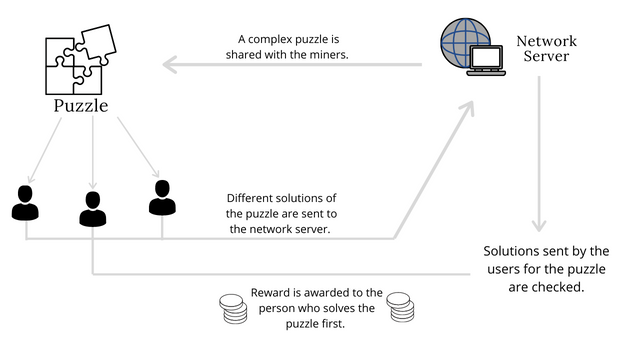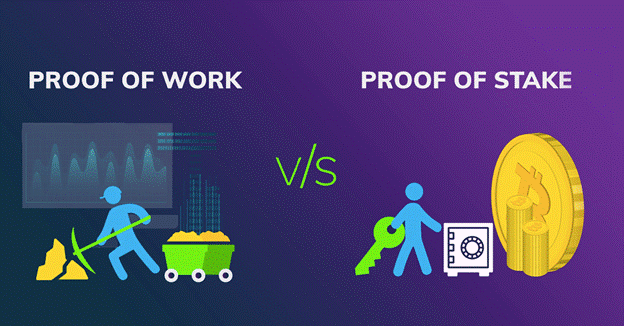What is the difference between PoW & PoS? Advantages & Disadvantages? Which one is better in scaling Capacity? Examples?
Greeting everyone,
I am back with my homework task 4 in this Academy. More i am engaged for my tasks, more i am learning about the crypto world. It feels wonderful in order to be get an opportunity to learn such things in a step by step process.
I shall start with the explanation of Consensus Mechanism on a blockchain.
In simple terms, it is a kind of methodologies through which we achieve an agreement along with trust and security.
In a decentralised system of blockchain, there are many number of nodes connected in the network. They work on verification and authentication of transactions on the blockchain. During such process, each node must reach a consensus protocol for the sake of security and to maintain the root-of-trust.
There are various types of consensus mechanism implemented in the blockchain.
- Proof-of-Work(PoW)
- Proof-of-Stake(PoS)
- Delegated-Proof-of-Stake(DPoS)
- Proof-of-Capacity(PoC)
- Proof-of-Burn(PoB)
- Practical Byzantine Fault Tolerant(pBFT)
- Proof-of-History(PoH)
Among all these protocols, PoW and PoS are well-known in the blockchain space.
Proof-of-Work(PoW):
Any number of transactions occuring in the blockchain goes to an unconfirmed block which has a maxium capacity of 1 megabytes. These are then duplicated across the participating nodes on the network. To carry out the verification process, the miners will have to solve the mathematical puzzle. Once verified, these data are added to the blockchain, transparent public ledger with their hash codes and timestamps along with their preceding ones.
If any of the transactions from the unconfirmed block is carried out simultaneously by the miners, the first one that gets validated will be added to the blockchain, thus the other one will be considered invalid by the system. This is how the network rejects the fradulent attempt. Moreover, all these valid transactions are stored in blocks arranged in sequential order. This also prevents users from double spending from their holdings.
In this mechanism, miners are chosen randomly based on the proportion of work done. The work done, i.e contributing computational power, by the nodes in a network is an evidence required so as to reach consensus in a decentralised nature. Besides, this incentivises every node to act honestly and record only valid trasactions. This way, it prevents bad ones from overtaking the network.
Proof-of-Stake(PoS):
As it has been mentioned above that, PoW requires tremendous amount of energy to solve an arbitrary mathematical puzzle in order to verify and validate transactions in the blockchain. This is one of the reasons, PoS evolved as an alternative to PoW consensus algorithm. Since, it does not require mining rig, it consumes low energy, thus, low cost.
PoS stands out to address an issue of consuming enormous amount of electrical energy to the proportion of coins owned by the miners. Based on the amount of coins owned, the miners are limited to mining an equivalent percentage of transactions. For example, if you own 6% of coins in a certain network, you can mine theoritically 6% of the blocks.
In PoS, a certain percentage of tokens always remains locked. By doing so, the users are rewarded with the tokens. This incentivises them to hold the crypto tokens instead of spending. As a result, it helps the price dynamics of the tokens. However, it is inclined to be centralised. This could make it less secure than PoW.
| S.N | PoW | PoS |
|---|---|---|
| CONSENSUS | Original | Alternative |
| SIGNIFICANT COSTS | Equipments+Electricity | Crypto Assets |
| PARTICIPANTS | Miners | Validators |
| REWARDS | Fixed | Variable |
| ENERGY | Inefficient | Efficient |
| SCALABILITY | Low | High |
| COST | High | Low |
| NATURE | Decentralised | Tends to Centralised |
| FIRST CRYPTO | Bitcoin | Peercoin |
Without the proof mechanism, the data stored in the network is more likely to be attacked and theft.
In term of scalability, PoS is much better than PoW. PoW has a limit in its capacity because of the block size and its frequency.
For example, we shall take the most popular cryptocurrency bitcoin network that runs on PoW protocol. The speed(transaction processing capacity) is limited by the block producing time of 10mins and the original block size of 1 megabyte. Because of these, the network's throughput is confined.
Whereas, the cryptocurrency Solana network that runs on PoS mechanism, has an extreme scaling capacity. It supports around 60,000 transactions per second.
As we have come to know that Ethereum is in a transition period to be moved from PoW to PoS. Time will tell if the bitcoin will follow the suit.
Thank you for your attention.
@sapwood
Kind regards
@sagarc



Hi @sagarc, Thank you for taking interest in the 4th Task of the Beginners Fixed Class. Your grades are as follows:
My Review and Suggestions:
You didn't complete the task correctly.
You didn't mention the advantages and disadvantages of PoW and PoS.
Give a space between each discussion for easy reading.
You are using a copyrighted photo, please replace it.
Use headers in each discussion title.
Thank you!
Downvoting a post can decrease pending rewards and make it less visible. Common reasons:
Submit